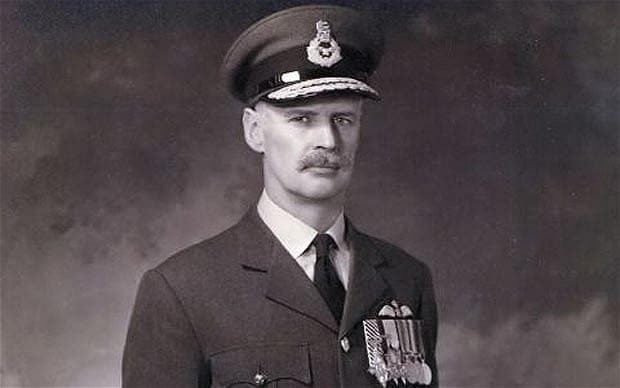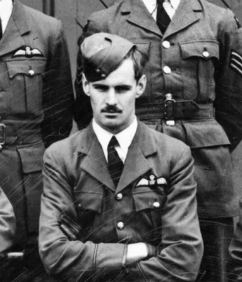Allegiance United Kingdom Name James Coward Awards Air Force Cross (AFC) Rank Air commodore | Service number 39412 Died July 25, 2012 Years of service 1937 - 1969 Role RAF officer | |
 | ||
Born 18 May 1915 ( 1915-05-18 ) Battles/wars World War IIBattle of Britain Battles and wars Battle of Britain, World War II | ||
Air Commodore James Baird Coward, AFC (18 May 1915 – 25 July 2012) was a British senior officer in the Royal Air Force. He was Air Officer Commanding Air Cadets and Commandant of the Air Training Corps between 1962 and 1966.
Contents

Early life
Coward was born on 18 May 1915 in Teddington, Middlesex, England. He was educated at the independent St John's School, Leatherhead, Surrey.
Military career
Coward was commissioned into the Royal Air Force as an acting pilot officer (on probation) on 28 January 1937. He joined No. 19 Squadron based at RAF Duxford as a pilot flying the Gloster Gauntlet, a single seat biplane. His commission was confirmed and he was regraded as a pilot officer on 16 November 1937. Having shown his artistic skill through caricatures of his comrades, he was tasked with painting the squadron badge on the canvas of the biplanes. However, after weeks of work, the Munich Crisis occurred and the biplanes, and their recently painted badges, were painted over in camouflage. His squadron was the first to be equipped with the Supermarine Spitfire, which entered service on 4 August 1938. He was promoted to flying officer on 16 June 1939.
With the outbreak of World War II, he was to serve as a pilot and staff officer. His squadron provided air support during the evacuation of the British Expeditionary Force from Dunkirk, between 27 May and 4 June 1940. On 2 June 1940, he was credited with the probable destruction of a German Messerschmitt Bf 109 fighter aircraft. During the Battle of Britain, on 31 August 1940, his squadron was scrambled from RAF Fowlmere to intercept a group of German Dornier Do 215s. He led the second section in attacking the bombers. The weapons of his Spitfire jammed and, having come under fire, the controls were damaged sending the aircraft into a dive. His left foot was almost severed from his leg. Upon bailing out, he couldn't stand the pain of the swift fall and deployed his parachute. During the now-slower descent he used the radio lead attached to his helmet to tie a tourniquet around his thigh and stem the bleeding. Upon landing in a field, he met a youth who quickly found a doctor. Within half an hour, he was taken to Addenbrooke's Hospital in Cambridge to have his left leg amputated. He was promoted to flight lieutenant on 3 September 1940.
Having taken five months to recover from the surgery, he joined the personal staff of then Prime Minister Winston Churchill. His main duty at Chequers, the Prime minister's country residence, was to judge if reports were urgent enough to warrant waking Churchill during the night. At Chartwell, Churchill's private home, he coordinated the air surveillance to warn the prime minister of any impending attack from nearby Nazi occupied France. He was promoted to squadron leader (temporary) on 1 December 1941. Shortly after this, he left Churchill's staff to become an instructor at the fighter training unit based in RAF Aston Down. He went on to command the Aircraft Delivery Unit, part of Transport Command, at RAF Croydon. In 1944, he transferred to the Air Ministry where he was in charge of operational fighter training. On 5 March 1946, he was made a war substantive squadron leader.
After the war, he was posted as an Air Attaché to Norway in 1946. He was promoted to flight lieutenant on 1 May 1947 with seniority from 1 December 1942. He was promoted to squadron leader on 1 November 1947 with seniority from 1 August 1947. He was given a permanent commission on 15 July 1948. He was promoted to wing commander on 1 July 1952. He was promoted to group captain on 1 July 1958. He was promoted to air commodore on 1 July 1962. Between September 1962 and June 1966, he was Air Officer Commanding Air Cadets and Commandant of the Air Training Corps.
Coward retired from the Royal Air Force on 8 September 1969.
Later life
Upon retirement, Coward and his wife moved to Canberra, Australia. There, he built one of the territory's first passively heated homes and converted a half-acre paddock into an organic garden. He died on 25 July 2012 in Yass, New South Wales. His wife survived him. He is buried in Michelago, New South Wales, alongside the two daughters who predeceased him.
Honours and decorations
Coward received the 1939–45 Star with the rare Battle of Britain clasp. He was awarded the Air Force Cross (AFC) in the 1954 New Years Honours.
Personal life
Coward married Cynthia Bayon on 29 December 1939. Together they had four daughters, two of whom predeceased him.
